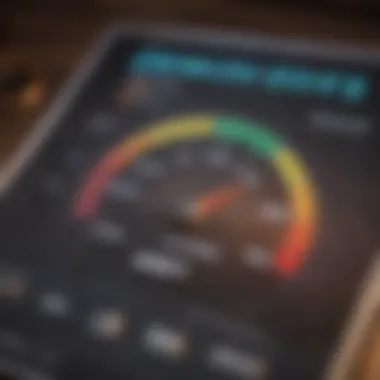Securing Loans with Poor Credit: Navigating Your Options


Intro
In every facet of financial life, credit history plays a crucial role. Individuals with a poor credit history often find themselves navigating a challenging landscape when seeking loans. This scenario presents unique hurdles that require careful consideration. Understanding the reasons behind one's low credit score is equally vital as exploring the various loan options available. In this article, we will delve into effective strategies for borrowing with poor credit, while emphasizing the importance of improving one's credit standing.
Overview of Financial Product
Definition
A financial product refers to any marketable instrument that holds some form of monetary value. Within the context of loans, this term encompasses various options such as personal loans, mortgages, and credit cards. These products enable individuals to borrow money, assess the cost of borrowing, and eventually determine their capacity to repay.
Key Features
- Flexibility: Many loan products offer flexible terms tailored to different needs.
- Varied Interest Rates: Depending on creditworthiness, interest rates can vary significantly.
- Different Repayment Plans: Borrowers may choose between fixed or variable repayment plans.
Purpose and Benefits
The primary purpose of these loans is to provide immediate financial assistance for personal, educational, or business expenses. The benefits of securing a loan can be considerable, as it allows one to manage unforeseen circumstances or make significant investments, even when facing a poor credit history.
Types and Categories
Loan Types
- Personal Loans: These are unsecured loans based on creditworthiness.
- Secured Loans: These loans require collateral, reducing lender risk.
- Payday Loans: Short-term, high-interest loans, often not advised for poor credit borrowers due to excessive rates.
Pros and Cons
Pros:
- Access to Funds: Enables borrowing despite poor credit.
- Potential for Credit Improvement: Responsible repayment can rebuild credit.
Cons:
- High Interest Rates: Poor credit usually results in less favorable rates.
- Risk of Debt Cycle: Unsustainable borrowing can lead to a cycle of debt.
Situational Uses
Understanding when to utilize these loans is crucial. For example, personal loans may work well for consolidating debt or financing unexpected expenses. In contrast, payday loans might only serve as a last resort due to high fees.
Application Process
Steps to Apply
- Assess Your Financial Needs: Clearly define the amount and purpose of the loan.
- Research Lenders: Look for those specializing in subprime lending.
- Gather Documents: Prepare necessary paperwork.
Eligibility Requirements
Lenders typically evaluate income, employment status, and current debts. A minimum income threshold is often required to mitigate risk.
Documentation Needed
- Proof of income (pay stubs or bank statements)
- Identification documents (driver's license or passport)
- Credit report, if available
Common Mistakes to Avoid
- Applying to too many lenders at once, which can hurt your credit.
- Failing to read the fine print on loan terms, leading to unexpected costs.
Tips for Success
- Improve Your Credit Score: Look for ways to boost your score before applying.
- Consider a Co-signer: A co-signer can enhance your chances of approval.
Costs and Fees
Types of Fees Associated
- Application Fees: Charged when you apply for the loan.
- Late Payment Fees: Penalties incurred when payments are not made on time.
Interest Rates and APR for Loans/Cards
Interest rates vary widely for borrowers with poor credit. It is essential to compare rates across various products to find the best offer.


Comparisons of Costs Across Options
Understanding the total costs, including fees and interest rates, is key. Secured loans typically have lower rates but involve risk due to collateral requirements.
Borrowing with poor credit is challenging but not impossible. Explore all your options carefully to make informed decisions.
Understanding Credit History
Understanding your credit history is crucial when navigating the complex landscape of loans, especially if you have a poor credit record. Your credit history reflects your past borrowing and repayment behaviors, and it plays a significant role in a lender's decision-making process. By grasping the importance of credit history, individuals can better position themselves to secure financing suited to their needs.
What is a Credit Score?
A credit score is a numerical representation of your creditworthiness, typically ranging from 300 to 850. It is generated based on various factors related to your credit behavior. A higher score generally indicates better creditworthiness, while a lower score suggests a higher risk for lenders. Most lenders look at credit scores provided by major credit bureaus like Experian, Equifax, and TransUnion.
A credit score influences loan applications, interest rates, and even rental agreements. It's an essential element that provides a snapshot of how you manage credit, which guides lenders in making decisions.
Factors that Impact Credit History
Multiple factors influence your credit history and, in turn, your credit score. Key elements include:
- Payment History: Timely payments elevate your score. Late or missed payments can severely damage your credit standing.
- Credit Utilization Ratio: This ratio compares your total credit card balances to your total credit limits. A lower ratio suggests responsible credit use.
- Length of Credit History: A longer credit history can positively affect your score, provided it is characterized by responsible behavior.
- Types of Credit Used: A mix of credit types, like credit cards, mortgages, and installment loans, may benefit your score.
- Recent Credit Inquiries: Too many hard inquiries within a short time can signal to lenders that you might be in financial trouble, potentially lowering your score.
Understanding these factors allows you to take strategic steps in improving your credit.
How Poor Credit History is Determined
Your credit history is deemed 'poor' based on specific markers such as a low credit score, chronic late payments, bankruptcy, or default. Lenders usually categorize scores under 580 as poor. Factors contributing to this designation can include:
- Delinquent Accounts: Accounts that are past due or not paid for a significant amount of time present a negative report to lenders.
- High Debt Levels: A high debt-to-income ratio can indicate financial strain, leading to a poor credit review.
- Public Records: Bankruptcies, foreclosures, or court judgments affect your credit standing adversely.
- Inactive Accounts: Lack of recent credit activity can signal to lenders an unwillingness or inability to manage credit effectively.
Understanding how these elements play a role ensures you're aware of your own financial standing and can make informed decisions moving forward.
Challenges of Getting a Loan with Poor Credit
Understanding the challenges faced by individuals with poor credit is critical when seeking a loan. A poor credit history does not simply imply a lack of creditworthiness; it also suggests potential hurdles in the loan application process. These challenges influence the options available to borrowers and affect the terms they may encounter.
Interest Rates and Loan Terms
Those with poor credit often encounter higher interest rates and less favorable loan terms. Lenders assess risk when determining interest rates, and a lower credit score signifies a higher likelihood of default. For example, while a borrower with excellent credit may secure a loan at a 4% rate, someone with poor credit might see rates soar to 12% or more.
These elevated rates can lead to significantly increased monthly payments, culminating in a greater total repayment amount over the lifetime of the loan. Additionally, loan terms may be shorter, restricting the repayment period and further compressing financial flexibility. Such circumstances necessitate careful planning from borrowers to manage these costs effectively.
Types of Lenders Available
Understanding the types of lenders available is equally essential. Not all lenders offer loans to individuals with poor credit. Traditional banks may have rigid requirements, often favoring customers with higher credit scores. In contrast, alternative lenders often cater to a subprime audience, albeit typically at a cost.
- Credit Unions: Smaller than banks and often more flexible in their lending practices, credit unions may offer better rates and terms to their members.
- Peer-to-Peer Lending Platforms: These platforms connect borrowers with individual investors willing to fund loans. Conditions can vary widely, allowing for competitive rates for those with poor credit.
- Subprime Lenders: Companies specializing in loans for individuals with lower credit scores. While they offer access, the fees and interest rates can be unreasonably high.
By exploring all available options, borrowers can make informed decisions about which lender aligns best with their financial situation.
Potential for Loan Rejection
A common reality for individuals with poor credit is the risk of facing loan rejection. Lenders tend to scrutinize credit history meticulously, with many opting to deny applications from those with questionable credit behavior. Factors contributing to loan rejections include:
- Recent missed payments or defaults
- High debt-to-income ratio
- Unstable employment history
A rejection can be disheartening, but it also serves as a critical juncture for reflection. Understanding the reasons behind a rejection can guide borrowers in taking steps to improve their creditworthiness for future applications.
"A rejection is not the end; it can be an opportunity to reassess your financial habits and work towards better credit standing."
Exploring Your Loan Options
Exploring your loan options is a critical step for individuals facing the challenges of a poor credit history. This phase involves assessing the various types of loans available, understanding their terms, and recognizing which lenders might be willing to work with borrowers with less-than-ideal credit scores. Selecting the right loan is not only about securing financial assistance; it also requires careful consideration of interest rates, repayment terms, and the potential impact on your future financial health.
By evaluating different loan types and sources, borrowers can find solutions tailored to their unique situations. Making informed decisions during this process can lead to better financial stability over time and help rebuild damaged credit.
Secured vs.
Unsecured Loans
Secured loans are backed by collateral, meaning borrowers offer an asset to the lender as a guarantee. This asset could be a home, a vehicle, or any valuable property. Because the risk to the lender is reduced, secured loans may have lower interest rates compared to unsecured loans. However, defaulting on a secured loan can result in the loss of the collateral, which creates a serious consideration for many borrowers.


On the other hand, unsecured loans do not require collateral. This means they often come with higher interest rates, especially for those with a poor credit history. Without the assurance of collateral, lenders may view these loans as riskier. Therefore, it’s essential for borrowers to weigh the risks and benefits of both loan types carefully.
A secured loan can offer better rates, but you risk losing key assets if repayment fails.
Peer-to-Peer Lending
Peer-to-peer lending is a newer method of obtaining loans through online platforms that connect borrowers directly with individual lenders. This approach often circumvents traditional banking institutions, which can be more restrictive with their lending practices. For individuals with poor credit histories, peer-to-peer lending can present more flexible options.
Borrowers benefit by potentially receiving lower interest rates than what traditional lenders would offer. Additionally, these platforms often evaluate borrowers on a broader range of factors than credit scores, which can be favorable for those with poor credit histories. However, it is crucial to understand the fees and terms involved in these loans before proceeding.
Subprime Lenders
Subprime lenders specialize in providing loans to individuals with poor credit scores. These lenders often have more lenient criteria than traditional banks, making it easier for borrowers to secure financing. However, one must consider the trade-offs. Subprime loans typically come with higher interest rates and fees, as lenders account for the increased risk of default.
Borrowers seeking out subprime lenders should conduct thorough research. Look for lenders with transparent practices and favorable terms. Understanding the cost structures and potential pitfalls of these loans will help you make a more informed choice.
Preparing to Apply for a Loan
Applying for a loan can be a daunting task, particularly for those with a poor credit history. However, being well-prepared is essential. This preparation can significantly impact the terms of the loan granted and the overall borrowing experience. Understanding what is needed before applying can make the process smoother and more manageable.
Checking Your Credit Report
Before anything else, checking your credit report is vital. This report provides a detailed account of your credit history, including outstanding debts and payment history. By reviewing it, you can identify any errors or discrepancies that could negatively affect your application. It’s important to obtain a copy of this report from major reporting agencies such as Equifax, Experian, or TransUnion. When you find errors, disputing them promptly can help improve your chances of receiving a loan.
Additionally, understanding your score aids in setting realistic expectations. For example, if your score is substantially low, you might need to consider options that cater specifically to subprime borrowers. This knowledge prepares you for discussions with lenders, allowing for more focused conversations.
Gathering Necessary Documentation
Proper documentation is crucial when applying for a loan. Lenders want to ensure that you have the means to repay borrowings. Typically, you will need to gather several documents. These may include:
- Proof of income: This includes recent pay stubs, tax returns, or bank statements.
- Identification: Government-issued IDs, such as a passport or driver’s license, are necessary.
- Proof of address: This can involve utility bills or lease agreements.
- Creditoreports: Having copies of your credit reports will allow you to discuss your credit in detail.
Having these documents ready not only speeds up the application process but also gives a sense of transparency with your lender. Presenting a well-organized file can inspire trust and confidence in your ability to manage loans responsibly.
Understanding the Loan Application Process
Knowing the loan application process is as important as preparing the documents. This includes understanding each step involved from submission to approval. Different lenders have various criteria and timelines, so familiarize yourself with theirs. Generally, the process includes:
- Application Submission: Complete the lender's application form accurately.
- Underwriting: After submission, the lender will evaluate your creditworthiness based on the provided details.
- Loan Approval: If evaluated positively, you will receive a loan offer outlining the terms, including interest rates and payment schedules.
- Funding: Once you accept the loan terms, the funds are disbursed.
It's wise to consult with lenders directly regarding their specific processes. Timelines and requirements can vary greatly. Being informed also enables you to prepare better for any potential delays and understand what might be required from you at each stage.
Keep in mind that being transparent and communicative with lenders can lead to a smoother application process. Borrowers often find that clear communication can help demystify many concerns that arise during this time.
Improving Your Creditworthiness
Improving your creditworthiness is a crucial aspect of navigating the often challenging landscape of loans, especially for those with poor credit histories. Having a good credit profile can open doors to better loan options and more favorable terms. This section will dissect various strategies that individuals can adopt to elevate their creditworthiness. Not only does a higher credit score increase the chance of loan approval, but it can also lead to lower interest rates and more flexible repayment terms in the long run.
Steps to Boost Your Credit Score
To raise your credit score, consider the following actionable steps:
- Pay Your Bills on Time: Consistently making payments when due is one of the most significant factors in determining your credit score.
- Reduce Credit Card Balances: Aim to keep your utilization rate below 30% of your total credit limit.
- Check Your Credit Report: Regularly review your report for any errors or inaccuracies that may be dragging your score down. You can request a free report at AnnualCreditReport.com.
- Avoid Opening New Accounts Frequently: Each application can temporarily lower your score, so only apply for credit when necessary.
By implementing these steps, you can gradually improve your credit score, thus enhancing your eligibility for loans.
Dealing with Existing Debt
Managing existing debt is essential to demonstrate responsibility to potential lenders. Here are some approaches to effectively handle debt:
- Create a Budget: Establishing a budget helps track expenses and allocate funds towards paying off debt systematically.
- Prioritize High-Interest Debt: Focus on paying down loans with the highest interest rates first to reduce overall financial burden.
- Consider Debt Consolidation: This can simplify your payments, potentially lowering your interest costs. Look into options through services like SoFi or Marcus by Goldman Sachs.
Proper management of existing debt signals to lenders your ability to handle financial obligations responsibly.
Establishing Positive Credit Behavior
Building a strong credit profile involves consistent positive credit behavior:
- Use Credit Responsibly: Use credit cards for necessary purchases but ensure you can pay off the balance in full each month.
- Only Borrow What You Need: Taking on minimal debts is wise, as this keeps your financial commitments manageable.
- Engage with Lenders: Maintain open lines of communication with your lenders in case of financial changes. Being proactive can help avoid potential issues.


By establishing these positive habits, you not only improve your creditworthiness but also build a trustworthy profile in the eyes of lenders.
Improving your creditworthiness is not just about boosting your score; it's about cultivating a responsible financial behavior that serves your long-term interests.
Strategies for Responsible Loan Management
Managing a loan responsibly is crucial, especially for individuals with a poor credit history. It can significantly impact both your financial situation and your credit score. Being vigilant about how you handle loans ensures that you do not worsen your credit conditions. Responsible management also nurtures healthier financial habits, which can provide stability in various aspects of your financial life.
Making Timely Payments
One of the most vital aspects of loan management is making timely payments. Actually, your payment history makes up a significant part of your credit score. Late or missed payments can lead to increased interest rates and potential loan defaults. To avoid this, create a straightforward payment plan. You can use automated payments or reminders to help you track your payments. Set aside a portion of your monthly income specifically for loan repayments. Also, should unexpected financial issues arise, contact your lender proactively. Many lenders provide options to temporarily adjust payment schedules or explore alternative arrangements.
Communicating with Your Lender
Communication with your lender is key when managing a loan. If you encounter difficulties, inform your lender right away. This can help in finding solutions before matters escalate. Do not hesitate to ask questions about your loan terms or your payment options. Lenders appreciate when you are engaged, and it might lead to more favorable adjustments or arrangements. Moreover, maintaining a good relationship with your lender can be beneficial if you seek future loans or need advice.
Understanding Loan Terms and Conditions
A clear understanding of your loan terms and conditions is essential. Each loan has specific guidelines regarding repayments, interest rates, and penalties for late payments. Take time to read through all documents carefully. Highlight any areas that seem confusing and seek clarification from your lender or a financial advisor. Knowing these details ensures that you are not caught off-guard by any fees or conditions that may arise. This knowledge also empowers you to make informed decisions that can aid in your overall financial health.
Remember, managing loans carefully contributes not just to improving your credit but also helps build trust with lenders, which is invaluable in the long run.
Alternative Options for Financial Assistance
Alternative options for financial assistance represent a crucial aspect for individuals seeking loans with a poor credit history. Traditional lending avenues may often remain closed to those with low credit scores. However, various alternatives serve as potential lifelines for borrowers in challenging situations. Understanding these options enables borrowers to make informed choices about their financial future.
Credit Unions vs.
Traditional Banks
Credit unions and traditional banks differ significantly in their approaches to lending. Credit unions are member-owned, often focusing on community service rather than profit. This structure can lead to more favorable terms for loans, as they typically offer lower interest rates and fees. Moreover, they may be more willing to work with individuals who have poor credit histories.
In contrast, traditional banks may adhere to strict lending criteria. They generally prioritize profit and often deny loans based solely on credit scores. Thus, for individuals with poor credit, credit unions present a viable alternative.
Key Considerations:
- Membership Requirements: Joining a credit union may require meeting certain eligibility criteria.
- Personal Service: Many credit unions offer personalized customer service, which can help build relationships with lenders.
- Range of Products: Credit unions may provide a broader range of financial products tailored to member needs.
Government Programs for Low Credit Scores
Government programs are essential resources for individuals with poor credit histories. These initiatives aim to support borrowers by providing access to funding that may otherwise be unattainable.
Programs such as the Federal Housing Administration (FHA) loans and additional state-sponsored initiatives often feature lower credit requirements. They also deliver benefits like reduced down payments. Understanding what is available at the federal, state, and local levels can greatly enhance a person’s ability to secure financing.
Highlights of Government Programs:
- Lower Down Payments: Many government-backed loans require significantly less upfront cash.
- Flexible Credit Guidelines: These programs often consider an applicant's overall financial picture beyond just credit scores.
- Potential for Home Ownership: Government programs can often help individuals achieve home ownership, an important goal for many borrowers.
Community Resources and Nonprofits
Community resources and nonprofit organizations play a pivotal role in assisting individuals with poor credit histories. These organizations often provide education, financial counseling, and sometimes even funding opportunities.
By engaging with community resources, borrowers can not only find loans but also gain valuable financial literacy. Programs may include workshops that help individuals understand budgeting, credit improvement, and responsible borrowing.
Benefits of Community Resources:
- Financial Education: Many nonprofits offer classes to help individuals understand their financial situation better.
- Access to Grants and Low-interest Loans: Some community organizations provide funding opportunities with more favorable terms than market loans.
- Support Networks: Engaging with community programs connects individuals to support groups which can provide encouragement and advice.
Ultimately, exploring alternative options for financial assistance can empower borrowers with poor credit histories, helping them navigate complex financial landscapes effectively.
By understanding the differences between credit unions, government programs, and community resources, individuals can make informed decisions that align with their financial goals.
Ending
Weighing Your Options Carefully
When navigating your loan options, it is essential to weigh these choices with diligence. First, evaluate interest rates. Poor credit often results in higher rates, which can lead to increased costs over time. Research various lenders to find the best possible terms suited to your situation.
Moreover, consider the type of loan you need. Secured loans may offer lower interest rates due to the collateral involved, whereas unsecured loans often present higher risks and charges. Understanding these distinctions can significantly influence your financial future.
Furthermore, assess the long-term implications of your decision. A desire for immediate funds must be balanced against the potential for long-term debt.
Ultimately, making informed choices, seeking the right lenders, and understanding loan products can greatly benefit anyone attempting to secure financing despite previous credit difficulties. Consider all aspects carefully and prioritize options that enhance your financial well-being.
“A well-informed borrower is a step closer to financial stability.”
Being cautious and employing a strategic approach while weighing your options is key. Doing so will aid you in navigating through a loan process that is often fraught with complications stemming from a poor credit history.



